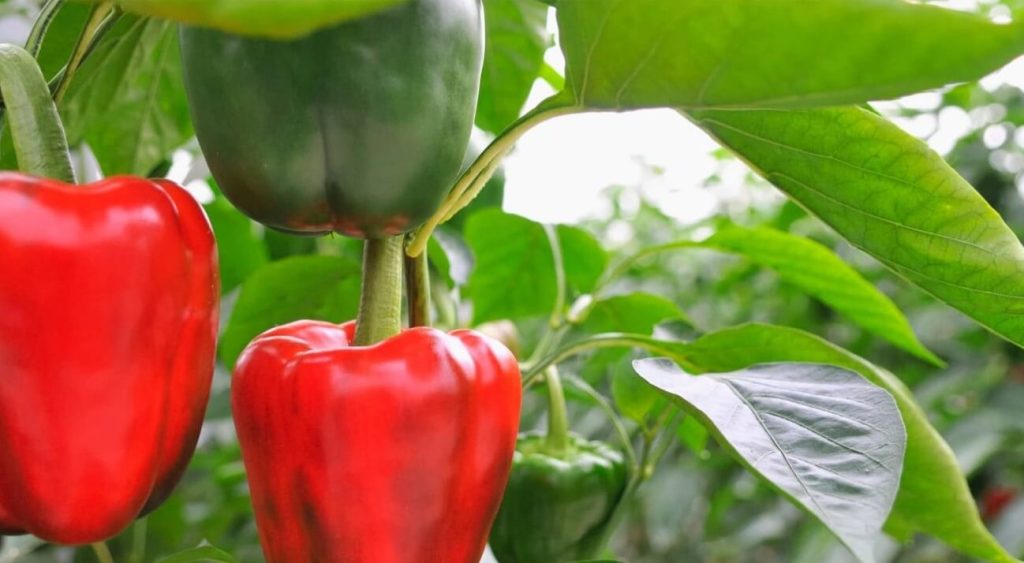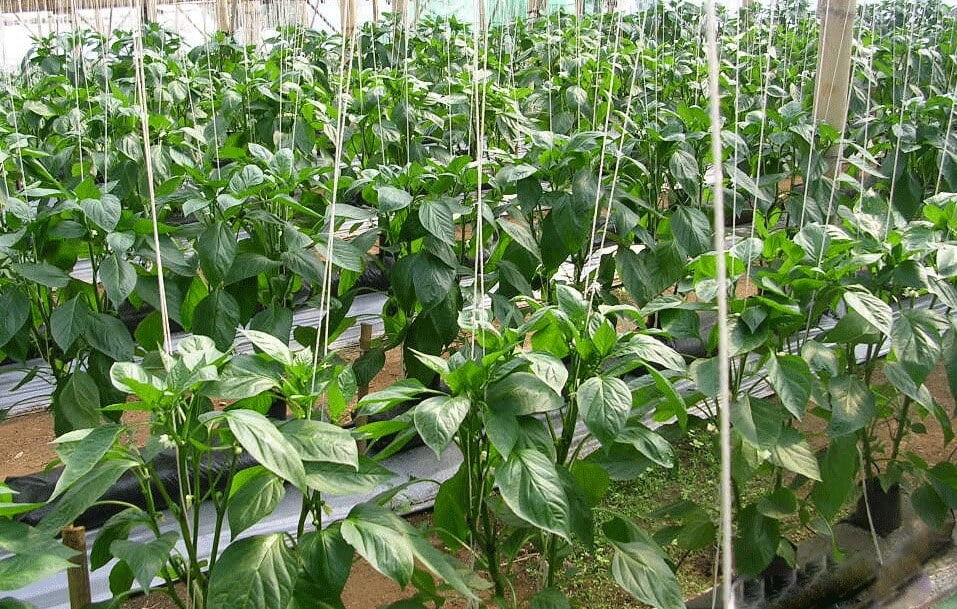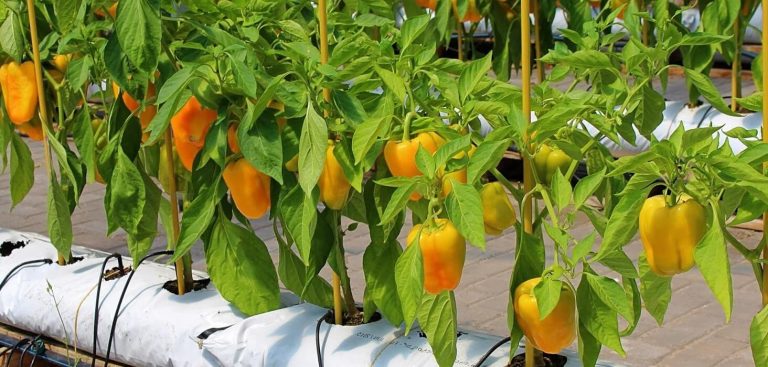How to fix yellow leaves on pepper plants? Pepper plants do have their share of potential problems. These plants are sensitive to problems like too much water, not enough water, very hot or cold weather, and not enough nutrients. These problems can manifest first as yellowing leaves before spreading to affect the entire plant.
When you notice those early warning signs of yellow leaves, it’s important to take action right away. To help your pepper plants grow better, find the cause and fix it. Ignoring yellow leaves can allow whatever is stressing the plant to become worse.
Key takeaways
- Overwatering and underwatering are common causes of yellow leaves. Allow the soil to dry out between waterings, but don’t let it get bone dry.
- Nutrient deficiencies like nitrogen and magnesium can cause yellowing. Fertilize with a balanced fertilizer.
- Diseases like blights and leaf spots turn leaves yellow. Remove infected plants to improve air circulation.
- Pests like aphids and mites cause yellowing. Use organic pesticides if needed.
- Cold weather and frost can damage leaves. Cover or bring plants indoors when it is cold.
- Chlorine in water can cause yellow leaves. Use filtered water.
- Once yellow, leaves don’t turn green again. Focus on new growth.
- Catch issues early before the plant is damaged.
- Prevent problems by watering properly, fertilizing, and monitoring for pests.
- Keep plants healthy and stress-free for the best results. Address problems promptly.
- Proper care and maintenance are key to preventing yellow leaves on peppers.
In this article, we will look at why your pepper plants might have yellow or pale leaves. I will explain the symptoms that state each cause and how to fix the problem. To help your peppers, adjust how you care for them so their leaves stop turning yellow. I’ll also give tips to prevent yellow leaves from recurring season after season.
Let’s start fixing this issue, so you can enjoy healthy pepper plants and their yields!
How to Fix Yellow Leaves on Pepper Plants? Underwatering

One common reason for yellow, drooping leaves on pepper plants is not enough water. Peppers need a regular supply of moisture to grow properly.
- Symptoms of underwatering:
- The leaves start yellowing from the bottom up
- Lower leaves appear dried out and curled
- Whole pepper plant wilts and droops
- Stunted growth
- Flowers and fruit drop off
When you don’t water enough, the roots don’t get moisture. This makes it difficult for the plant to absorb nutrients or move water through its tissues. Without enough water, photosynthesis and other plant processes slow down.
When leaves turn yellow, it means the plant is using them to feed new growth. But this survival mechanism only works for so long before the plant declines.
There are a few reasons why pepper plants may not be getting enough water:
- Not watering enough: peppers need 1-2 inches of water per week, more in hot weather
- Compacted soil prevents absorption
- Container plants dry out faster than garden plants
- Damaged or inadequate roots are unable to take up water
Note that peppers can tolerate drier conditions better than overwatering. But consistent underwatering will cause similar issues like yellowing and leaf drop.
Solutions for Underwatering

- Check soil moisture daily by touching the top few inches of soil. Water when dry, 1-2 inches down.
- Improve watering frequency to ensure peppers get adequate moisture.
- For container plants, water when the top of the soil is dry.
- Use mulch to help keep soil moisture longer.
- Relieve compacted soil by mixing in compost or punching holes with a fork.
- Repot pepper plants into loose, well-draining soil.
If you catch and fix underwatering fast, it can help pepper plants recover and grow well again. The key is staying vigilant about soil moisture and watering correctly.
How to Fix Yellow Leaves on Pepper Plants? Overwatering
Overwatering is one of the most common causes of yellow, drooping leaves on pepper plants. Too much moisture around the roots can lead to a host of issues.
- Symptoms of overwatering include:
- Leaves start yellowing from the bottom up
- Lower leaves appear limp, droopy, or curled
- Leaves may develop brown edges or spots
- Whole plant wilts even when soil is wet
- Flowers and fruits drop off prematurely
- Mushy or rotten roots
- Fungal growth on soil or roots
If you water too much, the roots don’t get enough oxygen. This can cause root rot diseases that harm the roots. The plant needs healthy roots to absorb water and nutrients for growth.
Overwatering also creates conditions ideal for fungal and bacterial problems. These can spread from the roots to leaves, causing spots, wilting, and leaf drop.
Common causes of overwatering pepper plants include:
- Watering too frequently, especially in cool weather
- Heavy soil that doesn’t drain well
- Excessive rain or irrigation
- Container plants that collect water in saucers
Solutions for Overwatering

- Allow soil to dry out completely between waterings. Check moisture a few inches down. [4]
- Improve drainage by adding compost to heavy soils. Repot plants if needed.
- Avoid overhead watering and water at the base of plants.
- Space plants appropriately to allow air circulation.
- Treat any fungal issues with organic fungicides. Remove severely infected plants.
- Protect plants from excess rain. Move container plants under shelter.
Catching overwatering early and improving conditions can help pepper plants recover. Severe cases can permanently damage roots. It’s crucial to monitor soil moisture and drainage.
How to Fix Yellow Leaves on Pepper Plants? Nutrient Deficiencies
If your pepper plants don’t have enough nutrients, their leaves can turn yellow and their growth can be stunted. The three main nutrients that are vital for healthy pepper plants are nitrogen, phosphorus, and potassium.
- Symptoms of nutrient deficiencies include:
- Uniform yellowing of older leaves first
Plants stunted or experience reduced growth.
- Leaves may curl or appear distorted
- Brown spots or patchy areas of dead tissue
- Poor flowering and fruit set
When plants lack nitrogen, their older leaves turn yellow. A lack of phosphorus results in leaves that are dark green or reddish-purple. Potassium deficiency leads to yellowing and necrosis at the leaf margins and tips.
There are a few potential causes of nutrient deficiencies in pepper plants:
- Insufficient fertilization when planting
- Nutrients leaching out of sandy soils over time
- Unbalanced pH prevents the uptake of nutrients
- Excessive rain washing away nutrients
- Overcrowding of plants competing for nutrients
Solutions for Nutrient Deficiencies
- Test soil to determine which nutrients are lacking
- Add a balanced fertilizer that contains nitrogen, phosphorus, and potassium
- For container plants, use a water-soluble fertilizer when watering
- Side-dress plants with compost or manure to provide organic nutrients
- Adjust soil pH to be slightly acidic, between 6.0 and 6.8, for best nutrient availability
- Space plants appropriately to reduce competition
- Use mulch to help keep moisture and nutrients near plant roots
Routine fertilization when planting and during the growing season can prevent nutrient deficiencies. Catching issues early and correcting nutrient levels will allow plants to recover.
How to Fix Yellow Leaves on Pepper Plants? Diseases
Pepper plants can have yellow, curled, and wilting leaves due to fungal, bacterial, or viral diseases. Common disease symptoms include:
- Yellow or light green spots on leaves that enlarge over time
- Dark brown necrotic lesions on leaves
- White fungal growth on undersides of leaves
- Leaves that appear distorted, curled, or wrinkled.
- Wilting and drooping of leaves and stems
Diseases that commonly cause these symptoms in peppers include:
- Bacterial spot – Caused by Xanthomonas campestris pv. vesicatoria bacteria. Produces greasy-looking spots that turn brown.
- Early blight – Caused by Alternaria fungi. Causes target-like concentric rings on leaves.
- Powdery mildew – Caused by Leveillula taurica fungus. Covers leaves in white powdery coating.
- Fusarium and Verticillium wilts – Fungal diseases that clog water conducting vessels.
- Viruses like Cucumber mosaic virus and Potato virus Y – spread by insects. Cause mottling, curling, and mosaic patterns.
Diseases thrive in warm, humid conditions. Overhead watering and crowded plants encourage spread. Diseases can severely impact pepper growth and fruit yields if uncontrolled.
Solutions for diseases:
- Remove and destroy infected plant material
- improve air circulation between plants
- Avoid overhead watering to keep foliage dry
- Apply fungicides or bactericides labeled for edible plants
- Control insect vectors like aphids and whiteflies
- Rotate crops in future seasons to prevent buildup in soil
Catching diseases early allows for better control. But repeated infections can damage plants long-term, so prevention is key.
How to Fix Yellow Leaves on Pepper Plants? Cold Weather
Cold temperatures can cause pepper plants’ leaves to turn yellow and fall off. Peppers don’t like the cold. They can get hurt when it’s colder than 50°F.
- Symptoms of cold weather damage:
- Wilting and drooping leaves
- Leaves turn pale yellow, then brown or black
- Dead patches on leaves
- curled, puckered leaves
- Stunted growth
- Flowers and fruits drop off
Prolonged exposure to temperatures below freezing (32°F) can be especially damaging. The water inside plant tissues freezes, rupturing cell walls. This cell damage causes the leaves to lose rigidity, wilt, and die.
Causes of cold weather damage:
Cold snaps or frosts can occur in the spring before peppers harden off.
In the fall, people bring plants indoors before temperatures plunge.
Keeping pepper plants too close to drafty windows or doors
Solutions for Cold Weather:
- Cover plants or bring containers indoors when cold temperatures are forecast
- Use cloches, cold frames, or row covers to protect plants in the garden
- Avoid planting peppers too early in spring or leaving them out too late in fall
- Improve insulation around windows and doors to prevent cold drafts
- Choose faster-maturing pepper varieties to allow earlier harvests
- Cold treat plants to help them better withstand temperature fluctuations
With quick action to protect plants, minor cold damage can be overcome. But severe exposure can damage pepper plants beyond recovery. Being prepared for cold snaps and avoiding unprotected exposure are key.
Best Practices for Watering
- Check soil moisture before watering. Water only when the top few inches are dry.
- Water deeply and infrequently. Avoid frequent, light watering.
- Improve drainage if the soil stays wet. Add compost or use raised beds.
Ensure Adequate Nutrition
- Test the soil and amend it before planting based on the recommendations.
- Use a balanced fertilizer at planting and mid-season.
- Sidedress with compost or manure for organic nutrients.
- For containers, use water-soluble fertilizer when watering.
Promote Good Air Circulation
- Space plants appropriately to allow air to circulate.
- Avoid overcrowding, which creates humidity and disease issues.
- stake or trellis plants to open up the foliage to air and light.
Check for Pests and Diseases
- Inspect plants routinely for early signs of pests or diseases.
- Remove infected plant material immediately to avoid spread.
- Use preventative measures like row covers if pests are a problem.
Take Care of Plants
- Hardening off properly transitions plants from indoors to outdoors.
- Use season-extending methods like cold frames or cloches when needed.
- Keep plants healthy and stress-free for the best disease resistance.
To keep pepper leaves from turning yellow, follow these tips for water, nutrition, and plant care. Stay vigilant and address any problems.
How to Fix Yellow Leaves on Pepper Plants? Conclusion
Here is a summary of the key points on diagnosing and fixing yellow leaves on pepper plants:
Diagnosing the Cause
- Check for signs of underwatering or overwatering, like wilting or soggy soil
- Look for pest damage or disease symptoms like spots or fungal growth
- Note if yellowing starts at bottom or top of plant to state nutrient issue
- Check for cold weather exposure or other environmental stresses
Fixing the Underlying Problem
- Adjust watering frequency and improve drainage if needed
- Add fertilizer or compost if nitrogen or other nutrients deficient
- Use insecticides or fungicides if pests or diseases present
- Protect plants from cold and frost until hardened off
Preventing Future Occurrences
- Water deeply but allow soil to dry out between waterings
- Test soil and fertilize appropriately before planting
- Promote air circulation and avoid overcrowding
- Inspect for early signs of pests or diseases
- Cover or bring plants indoors if cold weather expected
